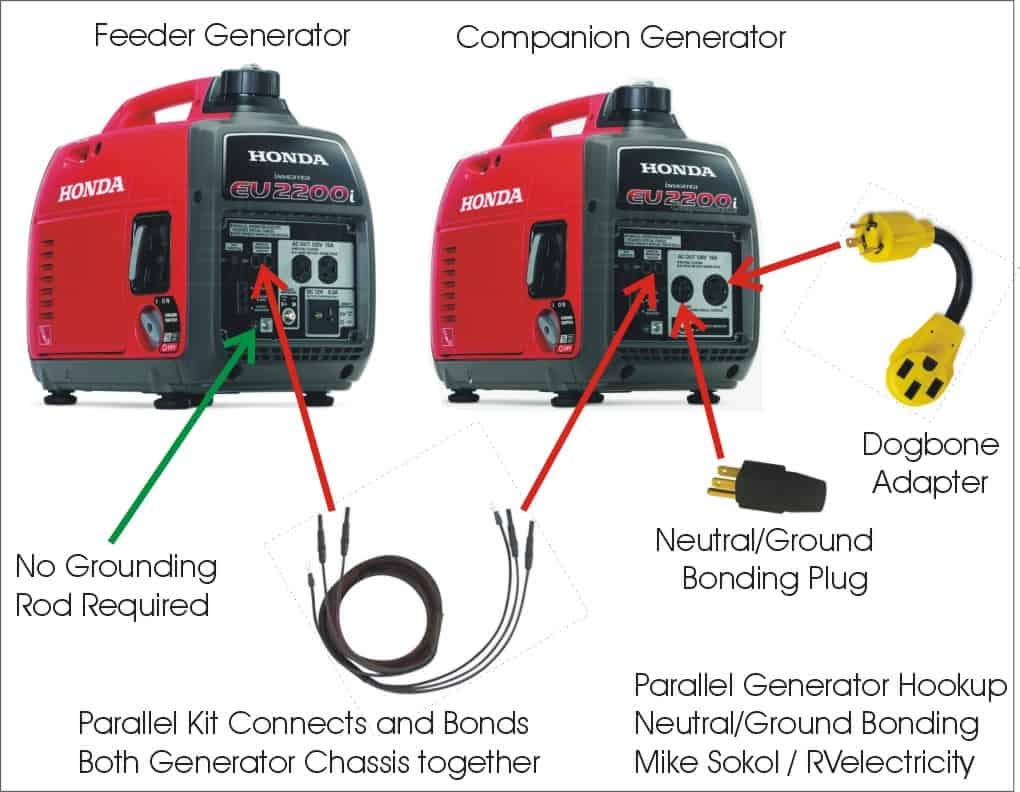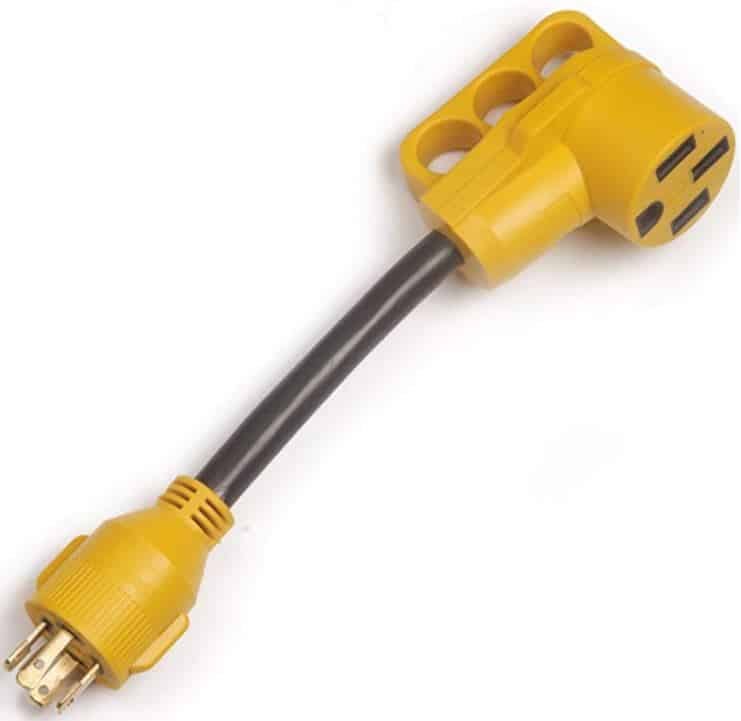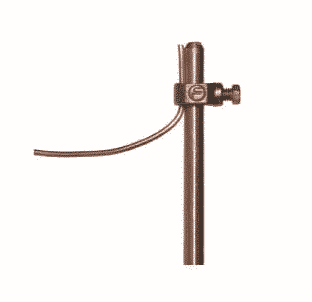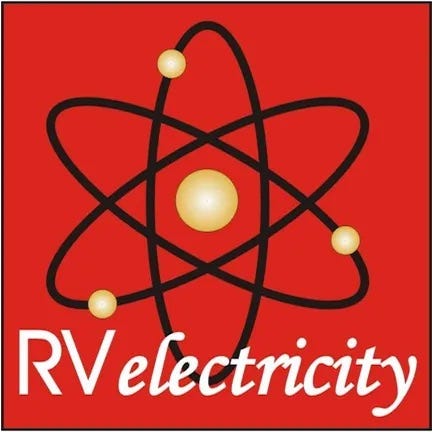Neutral Bonding Parallel Generators
It’s really pretty easy, and you only need one bonding plug…
Hello Mr. Sokol,
When pairing two inverter generators do you use a neutral/ground bonding plug on each generator or will one suffice? Thanks. —Dave H
Dear Dave,
Hey Dave, you can call me Mike (but I do make my long-suffering editor, Diane, call me Professor Sokol). (No he doesn’t, but I should. 😀 —Diane)
That’s a pretty easy question to answer once you understand the basic theory of parallel generator hookup. I’ve drawn up this simple diagram which should make the connections very clear. It’s really as easy as 1, 2, 3…. (and maybe 4).
For this exercise I’m going to assume you’ve got a pair of Honda EU2000i or EU2200i generators, one with the standard 20-amp duplex outlets (which I’ll call the feeder generator) and the other one being the Companion generator with both a single 20-amp outlet and a 30-amp twist-lock outlet.
Note that the EU2200i Companion generator can’t fully power the 30-amp outlet by itself unless you also have a Feeder generator connected with the parallel kit. But even in solo mode the standalone Companion generator’s 30-amp outlet will still work, albeit with limited current (18 amperes or so) and wattage (2,000 or so watts). That’s why it takes Two to Tango (as it were).
#1) Connect the matching generators together with the appropriate parallel cable kit, including the extra ground wire connection which bonds (connects) the two generator frames together.
You will want to get the official parallel kit for your particular generator since they must have a heavy-duty banana plug on each end with the terminal cover to protect you from contact shock if one of the plugs pulls out of the generator. So don’t be tempted to build this yourself. Get one made for your exact generators.
#2) Install a generator 15-amp bonding plug on the Companion generator’s 15/20-amp outlet.
You can buy a Southwire brand G/N bonding plug from a variety of vendors for around $15 or so. But this is simple enough to build yourself if you’re handy. I’ve detailed the DIY construction of this G/N bonding plug in dozens of published articles. And yes, I’m the guy who invented this thing.
#3) Connect an appropriate twist-lock Generator to RV TT-30 or RV-50 dogbone adapter into your Companion generator’s 30-amp outlet.
If your brand of “Companion” generator already has a TT-30 RV outlet, you can simply plug your RV’s 30-amp shore power cord into it directly, or use a TT-30 to RV-50-amp dogbone adapter to connect the parallel generator set to your 50-amp RV.
Note that there are two versions of a 30-amp generator twist-lock adapter: one with 3 prongs and one with 4 prongs. The 3-prong version is for the 120-volt/30-amp outlet you’ll find on most 2,000-watt “Companion” generators. The 4-prong version is for the 120/240-volt/30-amp outlet you’ll find on most 7,000-watt inverter generators. For this hookup you need the 3-prong/120-volt version.
#4) There is no need to connect either generator to a grounding rod in the earth unless you’re distributing power to multiple RVs, then it’s a code requirement.
Remember, grounding and bonding are two different (but related) things, and the frame of your generator(s) will be properly bonded to your RV chassis via the green/ground wire in your shore power cord, and the generators will be bonded together via the “ground” wire of your parallel kit. So it’s all good if you connect it as illustrated.
See … it’s really easy. Hope this helps.
Let’s play safe out there…. Mike








Hello Mike,
I've been reading and enjoying a lot of your generator articles (and also your sound articles) and am wondering something about the paralleling of smaller generators to get extra amperage / wattage:
I recently got a Predator 5000 from Harbor Freight (June 23 2025) after having used a (very loud, loaned but gratefully borrowed) Duro-Max (?) open frame generator for a show / festival last month. (May 2025) - part of a summer long monthly series of events. That generator did well for power but was just too loud even with the walls of cases we tried to block it with.
Last year one of the promoters had 2 Honda 2000 series generators and I had no issues using them both, for the whole season, but I only bonded the frames together and never thought to / got around to use a tester for open ground. They were not paralleled, I just used one for the stage / monitors and one for the PA and some LED lighting, and didn't (seem to) have any issues.
This time around, with my new Predator I still had no issues (especially not even NOISE!)
I made a bonding plug for one of the 20A outlets, and used the other 20A to a Furman power conditioner for the stage power, and used the 30A outlet via a 3-way 20A adapter to a pair of Furmans for the PA.
After having researched many various models as well as reading your articles, I was made aware of the open ground issue and paralleling possibilities of the various smaller Inverter models I looked at. My only concern was that the 3900W (on gasoline) might not be enough. (would it handle the subs? ;) )
I have pretty - to - very efficient amplifiers (Powersoft / Crown Xti / Lab Gruppen) and have been able to run this system on Grid power using 2 x 20A circuits for years without issue. (and too many times on only 1 circuit for smaller indoor or beer garden shows). So, I wasn't seriously worried (My First Generator Jitters).
During the loudest band of the evening and during a few DJs I was able to monitor the ammeter on the generator and was peaking around 15A/16A, (specs are 32.5A capable) so it seemed like the generator was doing quite well. The only thing was that they were smaller bands and this time around there were no guitar amps - just a bass amp all night and 6 monitor mixes. It seems like I have the headroom for 2 - 4 more instrument amplifiers for our upcoming shows, and the generator was handling most of the quiet sections of the night in Eco mode (I switched that off when the DJs and louder bands started).
But, I still wonder about hooking up a second generator - the promotor liked how quiet and powerful this one is, the weight and transportability are manageable mostly by one person, and it rolls a lot easier than last years Hondas. We may have some bigger shows coming up and the possible need / opportunity for a second generator, and this is where I still wonder something about paralleling.
TLDR:
In Looking at some of the responses here and in other articles, I have been wondering if the parallel ports are DC from the generator/alternator side - in effect adding the DC current together before going into the inverter section(s)? (I haven't made any measurements and the manual didn't really get into it).
On the one hand, It sort of looks like from the Red / Black parallel port output color coding that that would be the case.
However, the parallel kit that Harbor Freight sells for this model looks like it just seems to add the AC power and bond the frame ground together. If that is the case, do the inverter sections somehow monitor and sync the AC to keep everything in phase?
And just for your pro (audio and generator) opinion, depending on how the above answers come back: Do you think it's better to run two generators unparalleled as I've done in the past vs. possible problems having them not be in sync while paralleled?
Thanks for your articles, and the time you spend keeping everyone informed and safe!
What about two Yamaha EF2000ist generators running in parallel using the Yamaha Twin Tech Parallel Terminal kit? Which generator should the bonding plug go into?